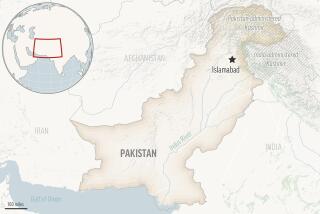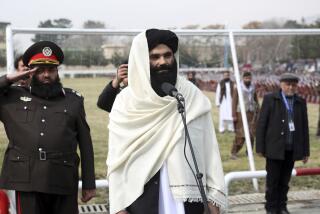U.S. concerns grow as militants move bases along Pakistan border
- Share via
Reporting from Islamabad, Pakistan — A militant network that is a major Western adversary in Afghanistan is expanding its reach into tribal badlands outside its longtime sanctuary in Pakistan, a move that could complicate U.S. efforts to eradicate the group.
Pakistani tribal elders in the Kurram region along the Afghan border say large numbers of fighters from the Haqqani network, an ally of Al Qaeda, have been stationing themselves in the highlands of their rugged district and are demanding the freedom to move in and out of Afghanistan at will to carry out attacks in the neighboring country.
The United States regards Haqqani militants, a potent wing of the Afghan Taliban that focuses on attacks in eastern Afghanistan, as one of the biggest threats Western coalition forces face in that nation. The group pioneered the use of suicide bombings in Afghanistan and was behind a 2008 assassination attempt on Afghan President Hamid Karzai that nearly succeeded. It has also led spectacular attacks on American military installations, including a brazen frontal assault last May on the Bagram airfield near Kabul, the Afghan capital.
American military commanders regard the group as a major roadblock to concluding the nine-year war in Afghanistan. Though the U.S. has endorsed Karzai’s push for peace talks with insurgent leaders, many in Washington see the Haqqani network as inextricably linked with Al Qaeda and therefore irreconcilable.
Haqqani militants have long maintained bonds with Pakistan’s powerful Inter-Services Intelligence agency, which has allowed the insurgents to use the North Waziristan region as their nerve center. A dramatic increase in U.S. drone missile attacks on the network’s compounds and training centers there this fall has helped trigger the movement of the militants during the last two months, experts and Kurram tribal leaders say.
Tribal elders in Kurram, who are sectarian rivals of the Haqqani network, say they believe the Islamic militant group views the snowcapped region as an ideal vantage point from which to launch forays into Afghanistan.
“If the Haqqani network spreads out like that, it will become very difficult for NATO forces to gather intelligence and strike the group,” said Khadim Hussain, coordinator at the Aryana Institute for Regional Research and Advocacy, a think tank in Islamabad, the Pakistani capital.
The Haqqani militants, native to eastern Afghanistan, have sheltered for years in Pakistan and have been largely concentrated in North Waziristan. The tribal area is essentially a no man’s land where militant groups, including the leadership of Al Qaeda, have been allowed to train and operate without interference from the Pakistani military.
With Pakistani military leaders refusing to pursue the Haqqani network, the Obama administration has ratcheted up the rate of drone attacks in Pakistan’s tribal areas. So far this year, the U.S. has carried out 97 drone missile strikes in northwestern Pakistan, including two Sunday that reportedly killed 13 people. That compares with 53 strikes in 2009 and 35 in 2008. According to the Long War Journal website, which keeps track of drone missile strike statistics, 88 of the attacks this year have occurred in North Waziristan.
U.S. and North Atlantic Treaty Organization forces have also stepped up pressure on pockets of Haqqani fighters in eastern Afghanistan. Since Oct.1, Western coalition forces have killed or captured 16 senior Haqqani leaders in the eastern province of Khowst, and have killed at least five Haqqani commanders in neighboring Paktia province, according to NATO spokespersons.
Haqqani movement into Kurram could force the United States to expand its missile strike campaign there, a move that might further inflame anti-American sentiment among Pakistanis who see the drone strikes as a gross violation of their country’s sovereignty. Right now, Islamabad tacitly allows the strikes against Al Qaeda, Taliban and Haqqani network targets in North and South Waziristan, and at times even facilitates those strikes with intelligence.
“It would mean big trouble between the two countries,” said Imtiaz Gul, author of “The Most Dangerous Place,” a look at militancy in Pakistan’s tribal belt. “It would amount to a lot of friction.”
Meanwhile, the appearance of Haqqani network fighters has exacerbated simmering sectarian frictions within Kurram.
Large swaths of the region are populated by a Shiite Muslim tribe, the Turi, which has been fending off attacks from local Taliban for years. Like the Haqqanis, the Taliban is Sunni Muslim.
The influx of Haqqani fighters has sparked fierce clashes with Turi tribesmen, said Musarrat Hussain Muntazir, a tribal elder.
After the fighting, Turi tribal elders began negotiations with a Haqqani contingent in hopes of ending a four-year, Taliban-imposed blockade of the only road that connects Turi lands in upper Kurram with the city of Peshawar, northwestern Pakistan’s major hub. The blockade has forced Turi villagers to take a circuitous, 230-mile trek into Afghanistan’s eastern provinces and then back into Pakistan in order to buy supplies or get to a hospital.
Recently, the Pakistani army has shut down five border crossings the Turi tribespeople have used to travel into Afghanistan. Pakistani army Col. Tausif Akhtar told the BBC that the military acted because “there have been sectarian clashes in Kurram, and we do not want miscreants from outside to exploit the situation.”
The Turi tribespeople want Haqqani leaders to persuade local Taliban militants to lift their blockade and to release nine Turi tribesmen they are holding. Haqqani leaders are demanding the use of Turi lands as a staging area for movement in and out of Afghanistan. So far, Turi elders appear reluctant to acquiesce.
“We don’t care what the Haqqani group does in Afghanistan, but we don’t want them to use our land in the fight against U.S. and NATO forces,” Muntazir said. “That’s why we attacked them when they came to Khaiwas.”
Turis are also concerned that a long-term Haqqani presence would result in civilian casualties from American drone strikes. Turi tribal elders say they doubt they can keep Haqqani militants out of their territory without help from the Pakistani military, which so far they have not received. “Obviously, if it wanted to, the army could stop this Haqqani movement into our lands and put an end to this fighting,” Muntazir said.
Pakistan, which regards the Haqqani group as a valuable hedge against Indian influence in a post-U.S. Afghanistan, has so far resisted repeated urgings from Washington to launch a major offensive against Haqqani network hide-outs in North Waziristan. A U.S. offer to Pakistan of $2 billion in military aid is seen by many as an incentive for Pakistan to mount an attack on the Haqqani network. Pakistan has told the U.S. it will eventually carry out that offensive, but only when it believes the time is right.
“I think they’ll start the operation,” said Hussain, the think tank analyst, “once every single fighter has moved out of North Waziristan and into Kurram.”
A special correspondent in the Kurram tribal area of Pakistan contributed to this report.
More to Read
Sign up for Essential California
The most important California stories and recommendations in your inbox every morning.
You may occasionally receive promotional content from the Los Angeles Times.










